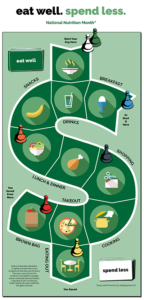NATIONAL NUTRITION MONTH: TIPS TO HELP LATINO FAMILIES IMPROVE HEALTH

Society for Public Health Education (SOPHE) encourages everyone to try new and healthy foods
Although March is officially National Nutrition Month, anytime is a good time to eat more nutritiously, points out the Society for Public Health Education (SOPHE). SOPHE offers 12 tips to help Latino-Americans eat more nutritiously.
“National Nutrition Month is an opportunity to learn more about nutrition and try new and healthy foods. Eating healthy foods can help weight management and lower risk for many chronic diseases like heart disease, type 2 diabetes, and cancer, which especially affect many Latino communities,” said Elaine Auld, CEO of SOPHE. She offered the following tips:
Go fresh. Choose fresh seafood, lean poultry, and beans as your protein source. If using ground meats, choose 93 percent lean ground turkey or ground sirloin beef.
Make fresh salsa or black bean dip. Store-bought salsa is often loaded with sodium. If you plan to have more than a tablespoon or two, fresh salsa is a much better option. Guacamole contains healthy fats, but is high in fat and calories.
Measure portions. It is easy to overeat on snacks. Measure one serving so you can save room for the main course.
Favor whole grains. Brown rice is a whole grain and has more nutrients than white rice. Use corn and whole wheat tortillas instead of those made with flour. Buy or bake whole grain breads and baked goods.
Use the plate method. Fill half of your plate with non-starchy vegetables. Fill one quarter of your plate with a lean protein. Then fill one quarter of your plate with a starchy food, such as beans or brown rice.
Use healthy cooking methods. Grill your chicken, fish, or vegetables. You can also try baking, steaming, or broiling. Small amounts of vegetable oil, olive oil, or cooking spray are better options.
Beans make a great protein source. Use dried beans when you can. They are lower in sodium than canned varieties. Always drain and rinse canned beans to remove excess sodium. If you are buying canned refried beans, buy fat-free varieties. Or make your own by blending whole black or pinto beans in a food processor with spices.
Go easy on the cheese. Cheese is high in saturated fat and in sodium. Queso fresco is a great choice if used in moderation. You can also try reduced-fat cheeses.
Substitute healthier options for sour cream. Non-fat Greek or plain yogurt and non-fat plain yogurt have a similar taste and texture to sour cream for much less calories and fat.
Cut your portion size when eating out. If you eat out, split the meal with someone else, eat half the meal and bring home leftovers, or order a kid-sized meal.
Snack on fruits and vegetables. Keep a bowl of fruit out on a table or counter to encourage healthy snacking. Pre-cut veggies and make “grab and go” packets.
Pack your lunch. Skip eating out and bring your lunch.
Substituting foods and even small dietary changes can lead to positive results, notes Auld. Researchers report that more than 40 percent of Latinos are obese.[1] Auld is working with SOPHE members and other partners to decrease those numbers.
“We want to help Latino communities, families and individuals overcome the barriers to good health,” Auld added. “We want to make healthy living easier where people live, learn, work, and play.”
The Society for Public Health Education is partnering in a three-year nationwide project called the National Implementation and Dissemination for Chronic Disease Prevention, funded by the Centers for Disease Control and Prevention. There are 97 projects in communities across the nation assisting people and communities in living healthier lives. Learn more at #Partnering4Health and www.partnering4health.org.
